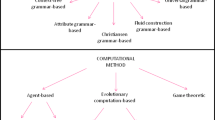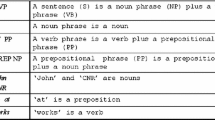Abstract
A platform for conducting experiments in the simulation of natural language evolution is presented. The system is paramaterized for independent specification of important features like: number of agents, communication attempt frequency, agent short term memory capacity, communicative urgency, etc. Representative experiments are demonstrated.
Access this chapter
Tax calculation will be finalised at checkout
Purchases are for personal use only
Preview
Unable to display preview. Download preview PDF.
Similar content being viewed by others
References
Carstairs-McCarthy (1998a). Synonymy avoidance, phonology and the origin of syntax. In Hurford, J. R., Studdert-Kennedy, M., & Knight, C. (Eds.), Approaches to the evolution of language. Social and cognitive bases, chap. 17, pp. 279–296. Cambridge University Press.
Carstairs-McCarthy, A. (1998b). The Origins of Complex Language: An Inquiry into the Evolutionary Beginnings of Sentences, Syllables and Truth. Oxford: Oxford University Press.
Cushing, S. (1994). Fatal Words: Communication Clashes and Aircraft Crashes. University of Chicago Press.
de Boer, B. (1997). Self organisation in vowel systems through imitation. In Coleman, J. (Ed.), Computational Phonology, Third Meeting of the ACL SIGPHON, pp. 19–25.
de Boer, B. (2000). Emergence of sound systems through self-organization. In Knight, C, Studdert-Kennedy, M., & Hurford, J. (Eds.), The Evolutionary Emergence of Language: Social Function and the Origins of Linguistic Form, pp. 177–198. Cambridge University Press.
Fodor, J. A. (1983). The Modularity of Mind. Cambridge: MIT Press.
Garrod, S. & Doherty, G. (1994). Conversation, co-ordination and convention: an empirical investigation of how groups establish linguistic conventions. Cognition, 53, 181–215.
Hurford, J. (1989). Biological evolution of the saussurean sign as a component of the language acquisition device. Lingua, 77, 187–222.
Hurford, J. (2000). Social transmission favours linguistic generalisation. In Knight, C., Studdert-Kennedy, M., & Hurford, J. (Eds.), The Evolutionary Emergence of Language: Social Function and the Origins of Linguistic Form, pp. 324–352. Cambridge University Press.
Jaynes, J. (1976). The Origins of Consciousness in the Breakdown of the Bicameral Mind. Princeton.
Kirby, S. (1998). Syntax without natural selection: how compositionality emerges from vocabulary in a population of learners. In Knight (Ed.), Second International Conference on the Evolution of Language. Oxford: Oxford University Press.
Kirby, S. (2000). Syntax without natural selection: how compositionality emerges from vocabulary in a population of learners. In Knight, C., Studdert-Kennedy, M., & Hurford, J. (Eds.), The Evolutionary Emergence of Language, pp. 303–323. Cambridge University Press.
Oliphant, M. (1999). The learning barrier: moving from innate to learned systems of communication. Adaptive Behavior, 7(3–4), 371–384.
Power, C. (2000). Secret language use at female initiation: bounding gossiping communities. In Knight, C., Hurford, J. R., & Studdert-Kennedy, M. (Eds.), The Evolutionary Emergence of Language, chap. 5, pp. 80–97. Cambridge University Press.
Schober, M. F. (1993). Spatial perspective-taking in conversation. Cognition, 47, 1–24.
Smith, K. (2002). Natural selection and cultural selection in the evolution of communication. Adaptive Behavior, 10(1), 25–44.
Steels, L. & Kaplan, F. (1999). Bootstrapping grounded word semantics. In Briscoe, T. (Ed.), Linguistic evolution through language acquisition: formal and computational models. Cambridge University Press.
Steels, L. (1997). Synthesizing the origins of language and meaning using coevolution, self-organization and level formation. In Hurford, J. (Ed.), Evolution of Human Language. Edinburgh University Press.
Vogel, C. & Woods, J. (2002). Simulation of evolving linguistic communication among fallible communicators. In Hurford, J. & Fitch, T. (Eds.), Proceedings of the Fourth International Conference on the Evolution of Language, p. 116. Harvard University, Cambrige, MA.
Woods, J. (2003). Declaratives, interrogatives, semantic space and the emergence of communication. Master’s thesis, Computational Linguistics Lab, Trinity College, University of Dublin.
Author information
Authors and Affiliations
Editor information
Editors and Affiliations
Rights and permissions
Copyright information
© 2007 Springer-Verlag London Limited
About this paper
Cite this paper
Vogel, C., Woods, J. (2007). A Platform for Simulating Language Evolution. In: Bramer, M., Coenen, F., Tuson, A. (eds) Research and Development in Intelligent Systems XXIII. SGAI 2006. Springer, London. https://doi.org/10.1007/978-1-84628-663-6_26
Download citation
DOI: https://doi.org/10.1007/978-1-84628-663-6_26
Publisher Name: Springer, London
Print ISBN: 978-1-84628-662-9
Online ISBN: 978-1-84628-663-6
eBook Packages: Computer ScienceComputer Science (R0)




